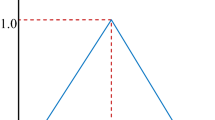Abstract
Social network analysis (SNA) is among the hottest topics of current research. Most measurements of SNA methods are certainty oriented, while in reality, the uncertainties in relationships are widely spread to be overridden. In this paper, fuzzy concept is introduced to model the uncertainty, and a similarity metric is used to build a fuzzy relation model among individuals in the social network. The traditional social network is transformed into a fuzzy network by replacing the traditional relations with fuzzy relation and calculating the global fuzzy measure such as network density and centralization. Finally, the trend of fuzzy network evolution is analyzed and predicted with a fuzzy Markov chain. Experimental results demonstrate that the fuzzy network has more superiority than the traditional network in describing the network evolution process.
Similar content being viewed by others
References
Araujo, E., 2008. Social relationship explained by fuzzy logic. Proc. IEEE Int. Conf. on Fuzzy Systems, p.2129–2134. [doi:10.1109/FUZZY.2008.4630664]
Bastani, S., Jafarabad, A.K., Zarandi, M.H.F., 2013. Fuzzy models for link prediction in social networks. Int. J. Intell. Syst., 28(8):768–786. [doi:10.1002/int.21601]
Brunelli, M., Fedrizzi, M., 2009. A fuzzy approach to social network analysis. Proc. Int. Conf. on Advances in Social Network Analysis and Mining, p.225–230. [doi:10.1109/ASONAM.2009.72]
Brunelli, M., Fedrizzi, M., Fedrizzi, M., 2014. Fuzzy m-ary adjacency relations in social network analysis: optimization and consensus evaluation. Inform. Fusion, 17:36–45. [doi:10.1016/j.inffus.2011.11.001]
de Sa, H.R., Prudencio, R.B.C., 2011. Supervised link prediction in weighted networks. Proc. Int. Conf. on Neural Networks, p.2281–2288. [doi:10.1109/IJCNN.2011.6033513]
Ebel, H., Davidsen, J., Bornholdt, S., 2002. Dynamics of social networks. Complexity, 8(2):24–27. [doi:10.1002/cplx.10066]
Freeman, L.C., 1978. Centrality in social networks conceptual clarification. Soc. Netw., 1(3):215–239. [doi:10.1016/0378–8733(78)90021–7]
Freeman, L.C., 2004. The Development of Social Network Analysis: a Study in the Sociology of Science. Empirical Press, Vancouver.
Hasan, M.A., Chaoji, V., Salem, S., et al., 2006. Link prediction using supervised learning. Proc. SDM Workshop on Link Analysis, Counter-Terrorism and Security, p.1–10.
He, Y.L., Liu, J.N.K., Hu, Y.X., et al., 2015. OWA operator based link prediction ensemble for social network. Expert Syst. Appl., 42(1):21–50. [doi:10.1016/j.eswa.2014.07.018]
Huang, Z., Lin, D.K.J., 2009. The time-series link prediction problem with applications in communication surveillance. INFORMS J. Comput., 21(2):286–303. [doi:10.1287/ijoc.1080.0292]
Jaccard, P., 1901. Étude comparative de la distribution florale dans une portion des alpes et des jura. Bull. Soc. Vaud. Sci. Nat., 37:547–579 (in French).
Jin, E.M., Girvan, M., Newman, M.E.J., 2001. The structure of growing social networks. Available from http://ideas.repec.org/p/wop/safiwp/01–06-032.html [Accessed on June 30, 2015].
Khorasani, E.S., Rahimi, S., Patel, P., et al., 2011. CWJess: an expert system shell for computing with words. Proc. IEEE Int. Conf. on Information Reuse and Integration, p.396–399. [doi:10.1109/IRI.2011.6009580]
Nair, P.S., Sarasamma, S.T., 2007. Data mining through fuzzy social network analysis. Proc. 26th Annual Meeting of the North American Fuzzy Information Processing Society, p.251–255. [doi:10.1109/NAFIPS.2007.383846]
Ryoke, M., Nakamori, Y., Suzuki, K., 1995. Adaptive fuzzy clustering and fuzzy prediction models. Proc. Int. Joint Conf. of 4th IEEE Int. Conf. on Fuzzy Systems and 2nd Int. Fuzzy Engineering Symp., p.2215–2220. [doi:10.1109/FUZZY.1995.409987]
Yan, B., Gregory, S., 2011. Finding missing edges and communities in incomplete networks. J. Phys. A, 44:495102.1–495102.15.
Zadeh, L.A., 1965. Fuzzy sets. Inform. Contr., 8(3):338–353.
Zhang, J.Y., Borland, R., Coghill, K., 2011. Evaluating the effect of health warnings in influencing Australian smokers’ psychosocial and quitting behaviours using fuzzy causal network. Expert Syst. Appl., 38(6):6430–6438. [doi:10.1016/j.eswa.2010.11.042]
Zhu, J., Xie, Q., Chin, E.J., 2012. A hybrid time-series link prediction framework for large social network. Proc. 23rd Int. Conf. on Database and Expert Systems Applications, p.345–359. [doi:10.1007/978–3-642–32597–7_30]
Author information
Authors and Affiliations
Corresponding author
Additional information
Project supported by the National Natural Science Foundation of China (Nos. 61272422 and 61202353)
ORCID: Yun-fang CHEN, http://orcid.org/0000-0002-7897-3588
Rights and permissions
About this article
Cite this article
Yang, Lm., Zhang, W. & Chen, Yf. Time-series prediction based on global fuzzy measure in social networks. Frontiers Inf Technol Electronic Eng 16, 805–816 (2015). https://doi.org/10.1631/FITEE.1500025
Received:
Revised:
Accepted:
Published:
Issue Date:
DOI: https://doi.org/10.1631/FITEE.1500025




